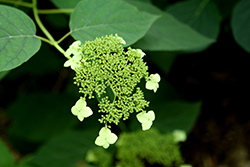It's all about ...
plants

Height: 6 feet
Spread: 6 feet
Sunlight:
![]()
![]()
![]()
Hardiness Zone: 3a
Other Names: Smooth Hydrangea, Sevenbark, Snowy Hydrangea
Description:
A hardy, showy shrub which features flat-topped, lace cap white flower heads in spring to summer, lasting for a long time; best if treated like a perennial and pruned to a few inches from the ground in spring, blooms on new growth; somewhat coarse
Ornamental Features
Silver Leaf Hydrangea features showy corymbs of white flowers with creamy white overtones at the ends of the branches from early to late summer. The flowers are excellent for cutting. It has attractive forest green foliage with silver undersides. The heart-shaped leaves are highly ornamental but do not develop any appreciable fall colour.
Landscape Attributes
Silver Leaf Hydrangea is a multi-stemmed deciduous shrub with a more or less rounded form. Its strikingly bold and coarse texture can be very effective in a balanced landscape composition.
This shrub will require occasional maintenance and upkeep, and is best pruned in late winter once the threat of extreme cold has passed. It is a good choice for attracting bees and butterflies to your yard. It has no significant negative characteristics.
Silver Leaf Hydrangea is recommended for the following landscape applications;
- Mass Planting
- Hedges/Screening
- General Garden Use
Planting & Growing
Silver Leaf Hydrangea will grow to be about 6 feet tall at maturity, with a spread of 6 feet. It tends to be a little leggy, with a typical clearance of 1 foot from the ground, and is suitable for planting under power lines. It grows at a fast rate, and under ideal conditions can be expected to live for approximately 20 years.
This shrub performs well in both full sun and full shade. It prefers to grow in average to moist conditions, and shouldn't be allowed to dry out. It is not particular as to soil type or pH. It is highly tolerant of urban pollution and will even thrive in inner city environments. Consider applying a thick mulch around the root zone in winter to protect it in exposed locations or colder microclimates. This species is native to parts of North America.
